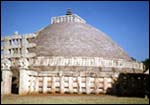

|
|
|
|
| HOME | TRAVEL | TRAVELOG | |||
 Dusty, Arid and Wonderful ... a journey into Madhya Pradesh
Kuntal Malia
Chances are your statement will have eyebrows hitting the ceiling -- perceived wisdom among the travel junkies is that MP is a bit like that place the late Dorothy Parker once cuttingly dismissed in these words: "When you get there, you find there is no there, there!" But to anyone who has actually been there and seen what Madhya Pradesh has to offer, these comments occasion wonder. You get to thinking, are people like, big time blind to the possibilities, the amazing variety the state has if you only care to look? One thing that needs mentioning upfront is that if you are into five-star tourism, you might as well bypass Madhya Pradesh as hundreds do every year. The state is not known for its variety of luxury hotels. However, the MP tourism department offers a very decent setup, and for those on a real shoestring, there are dharamshalas all over the place.
First up, a trip to Sanchi, 46 km from Bhopal, is essential. The famed Sanchi Stupa, one of the oldest religious structures in the world, erected by the Mauryan emperor Ashoka is the obvious attraction. The surrounding complex of awesomely sculpted toranas, temples, monasteries and intricately carved pillars transport you back in time, hundreds of years, to a more relaxed, peaceful world of monks and Buddhist chants and the ambience of a kingdom at peace, with itself and the rest of the world. The unique-looking stupa, perched on a bluff, commands a spectacular view of the serene green plains far below. If you are lucky a train may toot past, miles below, bringing one back to the present with a bit of a jerk. Pachmarhi, a hill station nestling in the Satpura ranges lies 165 km away from Bhopal. This is for lovers of tranquility, of the ethereal beauty of nature at its unspoilt best -- a world of murmuring rivulets and sal forests, valleys, mysterious ravines and mazes of gorges sculpted by time out of red sandstone. And if you are really lucky, the local wildlife decides to let you catch a glimpse or three. And if you like your relaxation mixed in with some more regulation sight-seeing, then the caves in the Mahedeo Hills are for you -- rock paintings, some of them over 10,000 years old, being the prime attraction. The perfect way to end your day at Panchmari is watching the sunset over Dhup Ghadh -- aaah, bliss. What I liked best about the place is that once you are there, getting from point A to point B involves walking -- and the walks take you through the beating, living heart of nature.
It is possible that this spirit of luxury and gaiety has prevailed in Mandu for a long time because it had for long been under Mughal rule. And under them, Mandu was declared a place for pleasure and, in fact, was renamed Shadiabad - The City of Joy. The Mughal rulers built exquisite palaces there like the Jahaz, shaped like a ship and large enough to house Ghiyath Shah's enormous harem. And Hindola Mahal, a strange-looking palace that looks like a livi ng optical allusion -- an assembly hall it is constructed to allow Mandu rulers to reach the upper reaches without dismounting from their elephants. There are outstanding specimens of architecture too at Mandu such as the Jama Masjid and Hoshang Shah's tomb.
Indore, which dates back to medieval times, is an ideal last stop on your MP itinerary -- if only because it so neatly straddles the past and the present. Planned and built by Holkar queen Rani Ahilyabai, one of the ablest queens, Indore has some interesting monuments of the period, the Lal Bagh Palace being perhaps the highlight, with its interiors modelled on the lines of the Versailles palace of the Sun King, Louis XIV. This gushingly lovely palace, which took 30 years to complete, sports every conceivable architectural frill ever invented. Built at an extraordinary cost by British architects, the sugary Lal Bagh looks as if it borrows a cupola or three from every famous palace of Europe. The sober seven-storey Raj Wada palace down the road is a sight more elegant.
Religion. Romance. History. Modernity. Nature at its most idyllic. Madhya Pradesh has it all -- so what's the matter, you want more?
For more information on travelling to Pachmarhi check out our travelog Whistlestop tour of Panchmari.
|
|
|
Tell us what you think of this feature
|
|
|
HOME |
NEWS |
BUSINESS |
CRICKET |
MOVIES |
CHAT
INFOTECH | TRAVEL | LIFE/STYLE | FREEDOM | FEEDBACK |
|